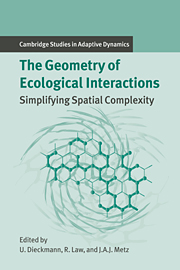Book contents
- Frontmatter
- Contents
- Contributing Authors
- 1 Introduction
- Part A Empirical and Statistical Background: A Plant Ecological Perspective
- Introduction to Part A
- 2 A Neighborhood View of Interactions among Individual Plants
- 3 Spatial Interactions among Grassland Plant Populations
- 4 Spatio-temporal Patterns in Grassland Communities
- 5 Statistical Modeling and Analysis of Spatial Patterns
- Part B When the Mean-field Approximation Breaks Down
- Part C Simplifying Spatial Complexity: Examples
- Part D Simplifying Spatial Complexity: Techniques
- References
- Index
- International Institute for Applied Systems Analysis
Introduction to Part A
Published online by Cambridge University Press: 14 January 2010
- Frontmatter
- Contents
- Contributing Authors
- 1 Introduction
- Part A Empirical and Statistical Background: A Plant Ecological Perspective
- Introduction to Part A
- 2 A Neighborhood View of Interactions among Individual Plants
- 3 Spatial Interactions among Grassland Plant Populations
- 4 Spatio-temporal Patterns in Grassland Communities
- 5 Statistical Modeling and Analysis of Spatial Patterns
- Part B When the Mean-field Approximation Breaks Down
- Part C Simplifying Spatial Complexity: Examples
- Part D Simplifying Spatial Complexity: Techniques
- References
- Index
- International Institute for Applied Systems Analysis
Summary
What have ecologists learned about spatio-temporal processes in natural communities? The first part of the book gives some answers to this question and is intended to provide ecological background to which theorists can turn. We believe such a basis is necessary if we are to achieve a constructive and enlightening dialogue between ecologists and mathematicians. The information in Part A indicates how ecologists think about spatio-temporal processes and sets boundaries on the kinds of spatio-temporal models likely to be of lasting interest in ecology. This part of the book is a small step in an iterative process of mutual education of theorists and ecologists.
Ecologists study many kinds of communities, and from this large set we have chosen to focus on plant communities living on land. The link between spatial structure and dynamics is particularly strong in these communities for two main reasons. First, plants in terrestrial communities are relatively immobile in space. Dispersal of propagules does less than one might expect to compensate for such immobility because most seeds do not travel far, even if they have structures that aid dispersal. Second, interactions occur primarily between immediate neighbors. Plants respond to the state of a small spatial neighborhood in their immediate vicinity, not some large-scale spatial average of the whole community (the so-called mean field). If there are circumstances in natural communities under which local spatial pattern should be important, they are in these terrestrial plant communities. The variation in spatial pattern from one location to another is both sensed and partially generated by the plants; such plant communities are therefore an obvious place to start looking for dynamics in which space plays an important part.
- Type
- Chapter
- Information
- The Geometry of Ecological InteractionsSimplifying Spatial Complexity, pp. 8 - 10Publisher: Cambridge University PressPrint publication year: 2000

